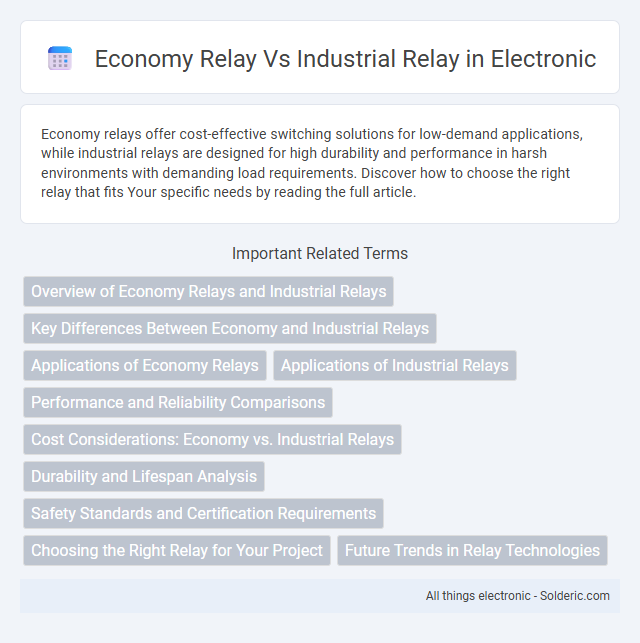Economy relays offer cost-effective switching solutions for low-demand applications, while industrial relays are designed for high durability and performance in harsh environments with demanding load requirements. Discover how to choose the right relay that fits Your specific needs by reading the full article.
Comparison Table
| Feature | Economy Relay | Industrial Relay |
|---|---|---|
| Price | Low cost, budget-friendly | Higher cost, premium quality |
| Durability | Moderate, suitable for light use | High, designed for heavy-duty usage |
| Application | Basic control circuits, consumer electronics | Industrial automation, machinery control |
| Load Capacity | Low to medium | High, supports large currents |
| Operating Environment | Clean, controlled environments | Harsh conditions, wide temperature range |
| Lifespan | Short to medium operational life | Long operational life, reliable performance |
| Switching Speed | Standard speed | High speed, precise switching |
| Certification | Basic standards | Industrial-grade certifications (UL, CE, IEC) |
Overview of Economy Relays and Industrial Relays
Economy relays are designed for basic switching applications with lower cost and moderate performance, typically used in consumer electronics and light-duty automation. Industrial relays offer higher durability, extended operational life, and enhanced resistance to environmental factors, making them suitable for heavy machinery, manufacturing processes, and industrial control systems. Both types serve distinct roles in electrical circuits, with economy relays prioritizing cost-efficiency and industrial relays emphasizing reliability and robustness.
Key Differences Between Economy and Industrial Relays
Economy relays are designed primarily for low-cost, light-duty applications with limited switching cycles and lower current ratings, making them suitable for basic control tasks. Industrial relays, on the other hand, offer higher durability, greater contact capacity, and enhanced protection features to withstand harsh environments and frequent operation demands. Understanding your specific load and operational requirements is crucial when selecting between economy and industrial relays for optimal performance.
Applications of Economy Relays
Economy relays are commonly utilized in low-cost, general-purpose applications such as lighting control, household appliances, and basic automation systems due to their simple design and reliable switching capabilities. These relays excel in environments where moderate voltage and current levels are sufficient, making them ideal for small-scale industrial equipment and consumer electronics. Their cost-effectiveness and ease of integration favor use in mass-produced goods and lightweight control circuits where advanced features are not required.
Applications of Industrial Relays
Industrial relays are designed to handle high voltage and current loads, making them ideal for heavy-duty applications such as motor control, automation systems, and manufacturing equipment. These relays provide enhanced durability and reliability in harsh environments, including extreme temperatures, vibrations, and electrical noise commonly found in industrial settings. Their robust construction ensures precise switching performance essential for process control, robotics, and power distribution systems.
Performance and Reliability Comparisons
Economy relays typically offer basic switching capabilities with limited durability designed for low-cost applications, while industrial relays provide enhanced performance with higher load capacities and robust construction to withstand harsh environments. The reliability of industrial relays ensures consistent operation under demanding conditions, minimizing downtime in critical systems. You should choose industrial relays when your application requires superior long-term reliability and precise performance metrics.
Cost Considerations: Economy vs. Industrial Relays
Economy relays offer a lower initial cost, making them suitable for budget-conscious applications with less demanding operational requirements. Industrial relays, while more expensive upfront, provide enhanced durability, higher load capacities, and longer service life, reducing maintenance and replacement expenses over time. Choosing between economy and industrial relays depends on balancing upfront investment against long-term reliability and operational demands in specific industrial settings.
Durability and Lifespan Analysis
Economy relays typically offer shorter durability and lifespan, designed for low-frequency switching applications with fewer mechanical operations. Industrial relays are built with robust materials and advanced contact technology, enabling them to withstand high-frequency switching and harsh environments, resulting in significantly extended operational life. The lifespan of industrial relays often exceeds millions of cycles, whereas economy relays may last only a fraction of that under comparable conditions.
Safety Standards and Certification Requirements
Economy relays typically meet basic safety standards such as UL and CSA certifications, suitable for low-risk applications with minimal industrial safety requirements. Industrial relays adhere to stringent safety standards including IEC, EN, and SIL certifications, ensuring compliance with rigorous industrial safety protocols and environmental conditions. These certifications guarantee enhanced reliability and protection in high-demand, heavy machinery, and automation environments.
Choosing the Right Relay for Your Project
Economy relays offer cost-effective solutions ideal for low-power, simple switching tasks, making them suitable for budget-sensitive projects with less demanding operational conditions. Industrial relays provide higher durability, enhanced performance, and resistance to harsh environments, essential for complex automation systems requiring reliable long-term operation. Selecting the right relay depends on power requirements, environmental factors, and the specific operational demands of your project to ensure optimal functionality and longevity.
Future Trends in Relay Technologies
Future trends in relay technologies emphasize increased integration of smart functions and IoT compatibility in industrial relays, enhancing automation and predictive maintenance capabilities. Economy relays are evolving to offer improved energy efficiency and miniaturization while maintaining cost-effectiveness for mass-market applications. Advancements in solid-state relay technology drive faster switching speeds and greater reliability, shaping the future landscape of both industrial and economy relay markets.
Economy relay vs industrial relay Infographic

 solderic.com
solderic.com